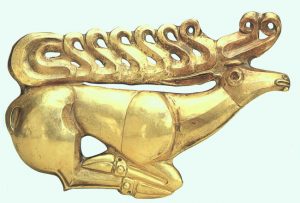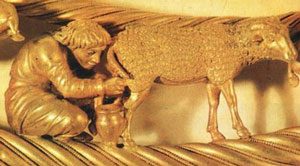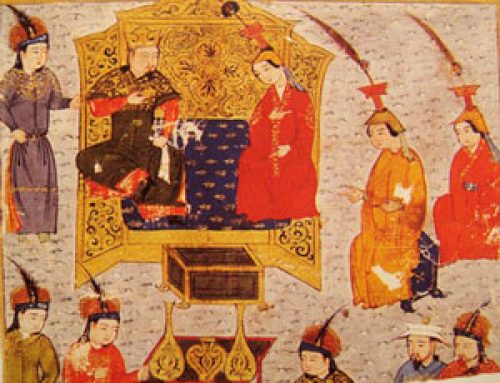
Scythian deer from about 700-500 B.C. It is made out of gold, and it’s now in St. Petersburg.
The Scythians were horse-riding nomads, who traveled around the western part of Central Asia taking care of their big herds of cattle and hunting wild animals like this deer. Scythian art was mostly small, so people could carry it around conveniently. For example, Scythian artists made a lot of gold ornaments, harness decorations, quiver decorations, belt buckles, and jewelry.

Scythian horse, ca. 900 BC(?)
Scythian artists began to produce these gold ornaments in the 600s BC. This may be because Scythian men were working as mercenary soldiers for West Asians to their south, and the West Asians were paying them in gold. Their payment, and their need to find useful ways to spend their gold, may have been related to the development of coinage about this time.

Scythian deer (600s BC)

Scythian milking a sheep (Tolstaja Mogila kurgan, Ukraine, 400 BC)
Their style, and their poses, closely resemble the figurines that Greek and Romanian artists were producing about the same time, during the Greek Dark Ages and the Archaic period.

Kazakhstan, ca. 400 BC
By 400 BC, the Scythians, like their Greek neighbors, were experimenting with different poses and more interesting compositions, like this man milking a sheep.

Two hunters with bows (Kerch, on the Black Sea, ca. 400 BC)
The flatter composition is also more Indian. And are these hunters, with their curved bows, the model for this Chinese scene?
Learn by doing: make a small figurine out of clay
More about Central Asian art
Bibliography and further reading about Scythian art:
The Golden Deer of Eurasia, by Joan Aruz of the Metropolitan Museum of Art (2000). Exhibit catalogue, along with a sophisticated discussion about the relationship between nomads and settled people in Central Asia, and the effect of trade between them on their art.
Scythian Gold, by Ellen Reeder (1999). Catalogue of an great exhibit of Scythian material from Ukrainian museums, which was shown at the Met in New York, among other places.




